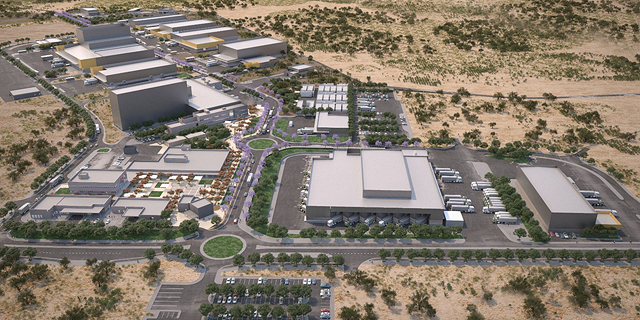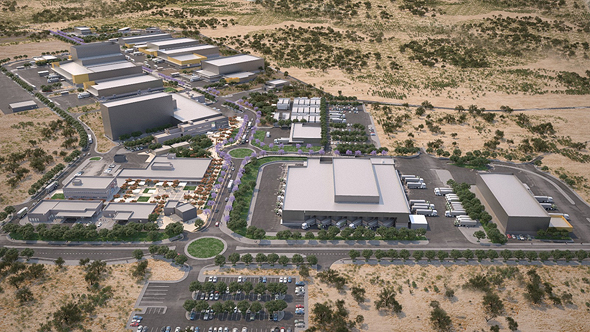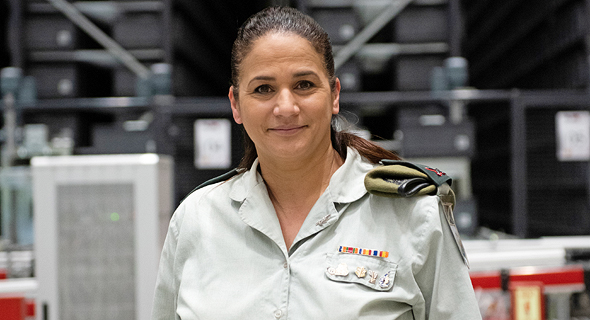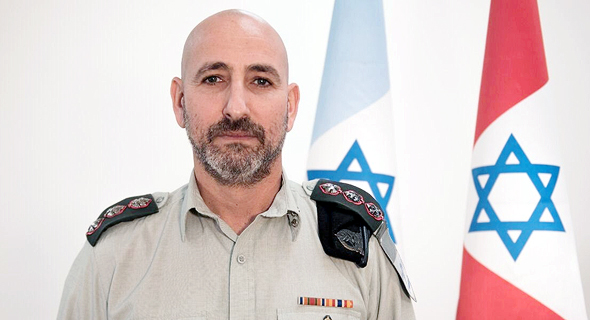
Move over Amazon, the Israeli military is equipping its warehouses with artificial intelligence
The IDF will build three logistic centers costing $1.7 billion, integrating new technologies that will become available to civilian companies
Neta-Li Binshtok | 10:52, 16.04.21
The transition to online shopping and the boost of online global retail sites like Amazon and AliExpress increased the importance of logistics and supply chain management. The world is transitioning to large logistic centers that are as autonomous as possible. Optimization is the name of the game, and robots and artificial intelligence systems have begun to take on a significant role.
Surprisingly, the entity that is building the largest logistics center in Israel isn’t the Shufersal supermarket chain or Teva Pharmaceuticals - but the Israeli military. The problems that frequently characterize Military logistics, such as mismanagement of reserve unit equipment or emergency storage facilities that are discovered to be empty, are well-known. Currently, the military is attempting to resolve those issues by harnessing new technologies.
Three state-of-the-art logistics centers will be built from scratch in the northern, central, and southern regions of the country to replace existing storage facilities that have been around since the British Mandate in Palestine, and converge all military equipment under a single roof. Currently, equipment is spread out over 17 army bases, which will be cleared out and with the land being repurposed for 457 acres of new construction. The initiative, which was first revealed by Calcalist, will lead to huge savings in manpower and optimizing equipment, and will save millions of shekels a year. But aside from the significant scope of such a project, it is a profound change for the Israeli military to imitate Amazon, and for the first time enable a civilian entity to manage its operations.
Anyone who served in the Israeli military can understand how complex and divergent such a project could be for the military system, requiring it to change its skin. Some of its warehouses and storage facilities will be replaced by advanced automated systems, which are currently mainly managed in an outdated and manual format.
To oversee the largest-ever project of this sort, the military appointed Brig. Gen Meirav Brickman, the head of the Israel Defense Forces’ Central Supply Center alongside Brig. Gen Sagiv Sharvit, head of the center’s Planning Division. The duo traveled around the country and the world to search for the perfect logistics center.
“There isn’t a single logistics center in the country that I haven’t visited, and I am intimately familiar with their technologies and nuances,” Sharvit said. “We went and scouted military supply centers around the world too. Surprisingly, India has one of the most advanced centers in the world, while U.S. logistics centers are very underdeveloped. In Europe, the centers are mainly automated, while in the U.S. it’s still mostly done manually. There isn’t anything similar out there to what we were looking for. The military center is like a huge brick. When you break it down into components, there are civilian equivalents. I store medical supplies, and there’s a civilian company that does the same thing. If I store food, there are also plenty who do that as well. But there isn’t any company that stores medical supplies, alongside frozen and dry food, next to spare parts and fuel. The essence of our project is in its scope and complexity. For the sake of comparison, the largest logistics center in Israel features 5,000 unique items, and we have 360,000 of them.”
Brickman: “Logistic centers in Israel usually have a certain specialty. But at the end of the day, we are an army - we need to prepare these centers for different levels of emergencies. That’s why the logistical challenge is great. We’re not just talking about war scenarios, but also other crises, like the coronavirus (Covid-19) pandemic for example, when we found ourselves in the midst of a crazy logistics operation.”
During the height of the pandemic did you put the project aside?
Brickman: “On the contrary, we sped up the project. At first we feared that it would be delayed, but since the military was actually involved in managing the crisis, there was a need for these logistics. The project transitioned from routine-mode to operational-mode, and during that time the system aligned. An understanding was reached: the military is supported by one entity that gives it everything, and responds to every division, unit, and base.”
Beyond their scale, how do these logistic centers differ from what already exists?
Sharvit: “Some of the technologies we plan on incorporating already exist out there, but are limited in scope and scale. At the planning stage, we hired Rosenstock Shippur as consultants to help us understand our needs. We traveled with them around the world and searched for what would fit our needs. The center’s uniqueness lies in incorporating many different technologies. The most basic thing we’ll have is an automated storage facility, without the need for forklift operators. A forklift can reach up to 14 meters high (46 feet), but we’ll have a robot that can reach up to 35 meters (115 feet). Think of how much additional storage space you can add, with height alone. A forklift operator performs between 10-25 collection maneuvers per hour, but a robot could do 100. It’s efficiency is exponential. Technologically-speaking, we’ve incorporated many things, including technologies that don’t yet exist in Israel.”
Containers have a barcode and light up
Two of those technologies that make Sharvit’s eyes light up are “pick by pick” and “light by voice. “Basically, the robot sits near a conveyor belt with a package that was for the Paratroopers 101 Battalion for example. It doesn’t know who the package is for, it has a barcode and it lights up signalling: take two of this item, three of that one. When I send medical equipment to an army unit today, the forklift needs to look through the packages and check whether it has taken the 200 grams of a certain antibiotic and not 300. It needs to check a few times that it has taken the right item. Here, it doesn’t have to ‘know’ anything. When it takes two items and throws it into a package - the system measures it. If it makes a mistake, the system will alert that there is a mistake in the packaging. It’s proficiency has to be much simpler. Using the ‘pick by pick’ device, the system functions as a sort of Waze and navigates the logistics center, it communicates with it and tells it what to do. It doesn’t even know what it’s taking. In the past a logistics worker may have personally known someone in a certain battalion and added extra items to their shipment. Nowadays, that can’t happen anymore. The system doesn’t even know where the package is going. It’s all very accurate. It also eliminates situations where a unit calls up a center and complains that ‘I ordered one thing, but received something else.’”
Sharvit clarifies that innovation isn’t just about incorporating new technologies. “Bringing this technology here is one thing,” he said. “Today, when logistics centers want to bring a certain technology to Israel, they need to think twice, because a company may not have a customer service center here or store replacement parts. But once we bring it here, we’ve created an infrastructure that can be used in the civilian sphere as well. Now, when a civilian body wants a certain technology, it’s already accessible, also in terms of service and maintenance. It’s an infrastructure leap forward not just for the military, but for the civilian world as well.”
Are there Israeli technologies at this center too?
Sharvit: “We are constantly assessing that issue, but it’s worth noting that it’s no longer us, it’s the franchisee. A few weeks ago MySize approached us with an offer, I told them they had us intrigued but should speak with the franchisee. No one wants to be a guinea pig, but the goal is to constantly add new capabilities, and that’s in our contract as well as the franchise’s. One of the innate tensions is the desire to integrate innovative technologies, but at the same time to not bite off more than we can chew. When companies approach us with offers, we want to first know how it works and then we’ll talk.”
The next stage? Ammunition
The IDF outsources the establishment of the new IDF logistics centers under a private finance initiative (PFI), where the group awarded the tender will construct the facility on its own and earn the rights to operate it for the next 25 years. Five different groups approached the Israel Ministry of Defense to build the new logistics center: Shikun & Binui, the Maman Group and Allied Logistics Ltd; Ashtrom Group, Afcon Holdings Ltd., and Flying Cargo; the Shapir Group and Orian Lev Haaretz Logistics Center; Minrav Holdings Ltd., Electra, and Leidos; and Yeshuv and Seldat Distribution Inc. On Jan. 20, Orian and Shapir were awarded the tender, in which Shapir will build the facility and maintain it, while Orian will operate it. Shapir is responsible for 60% of the project while Oryan is responsible for the remaining 40%. Orian will operate the logistics centers in the central and southern areas, while the northern facility will be run by the IDF directly, backed by two other companies.
The cost of the project is estimated to be around NIS 5.5 billion ($1.7 billion). In September 2021, the franchise is expected to break ground on the southern center in the Mishmar Hanegev region, which will open over the course of 2024. According to the agreement, the central logistics center will open near the city of Shoham and in the north near Netafim. The centers will be located on military-owned land, but be built from scratch. During the following stage, military ammunition will also be moved there, although for security concerns, it will be placed in bunkers near the centers and not within them.
“The army learnt plenty of lessons from similar projects it carried out in the past,” said Sharvit. For example, “one lesson that we took for the construction of the massive new bases in the south, we didn’t allow any companies to submit a tender as a sole entity, it had to be at least two companies to qualify. The construction companies and logistics ones won the tender together, and this yielded much better quality results. This project is quite large. Even writing up a bid for the tender demanded an investment of around NIS 10-15 million ($3-$5 million).”
The process, prior to construction, began once the military started preparing infrastructure, and Brickman is well-acquainted with the organization’s limitations. “We went over a large process of merging all equipment centers - such as food, replacement parts, logistics and medical supplies, and fuel - it was all done beforehand,” she said.
“To allow such a change, the system needs time, it’s a long process. That’s why the process started with internally merging divisions, and as we all know, there could be a thousand different reasons why mergers in the civilian sector don’t succeed. The organization needs to shift from everyone working independently to a converged method, with all the centers speaking the same language. Within four years we expect to leap 40 years ahead in terms of logistics capabilities. This is the largest logistics revolution in Israel, not just in scope but rather in terms of area and managing storage facilities. In Israel, there are a lot of advanced large storage facilities, but none like this.”
Sharvit added: “IDF units worked in a different system than ours, they managed small inventory systems. In preparation for this change, we transitioned all systems to be like our own. It seems simple, but the process is long and complex, and we invested over NIS 100 million ($30.5 milion) in unifying all the data systems.”
Are there positions in the military that could disappear as a result of this change?
Sharvit: “Yes, it seems semantic but it’s not. It takes a certain type of skill to manage a facility where it’s all manual except for the inventory management systems. Running an automated warehouse with conveyor systems like the WMS (warehouse management system, which manages supply chains), is completely different. Nowadays, one needs to know how to manage people, but tomorrow they will need to be able to manage entire systems.”
“The penny dropped when I first visited a logistics center in Germany. During one of the tours, I saw a pallet being transferred and asked a warehouse employee what was inside, and he told me he didn’t know. He didn’t even know what it was for. He doesn’t even need to know an item’s location or who decides where it should be placed. For optimization purposes, it’s the system’s responsibility. It learns about the item and the frequency it’s used. It finds an optimal place in the storage facility without requiring human interference. Those are entirely different skills. A person who makes those decisions or manages such a facility has it all in their head. Now, they’ll let the system manage it. Even a simple process such as counting inventory once a year could be done that way. These days we shut down a facility for two weeks, and count everything by hand. The WMS system does all the counting in real-time. The profession is changing and its qualifications are too.”
Cutting down a third of logistic manpower
The Israeli military estimates that it will cut down on a third of its logistic manpower due to the automation process. “We are in the process of reorganization, and it’s important to preserve our workforce,” Brickman said. “We’re currently in the throes of a natural process - whoever leaves, we don’t replace them. We are functioning with a certain shortage in order to build ourselves and move forward. The savings isn’t only in manpower, but also in property taxes and electricity expenses. Today, we’re deployed across 17 different military bases, and are cutting it down to three.”
“All of the centers will be built with green energy,” adds Sharvit, “today it might sound standard, but in 2015 when we demanded solar roof panels, people looked at us funny. Our electricity use will go down to zero because we’ll generate all of it ourselves. Aside from saving millions of shekels, our property taxes will go down to NIS 25 million ($7.6 million) a year. There are other aspects to saving too, in terms of inventory retention. The WMS system produces inventory leverage, as opposed to 99.8% inventory loss. It allows us to control nearly the entire army’s inventory. At this scope, every bit of inventory could end up costing us millions a year. Not just in terms of missing inventory, rather in terms of expired or lost inventory due to improper storage and management. Sometimes due to restraints, inventory can be found in an open area or without tarpaulin covering. After the transition, we’ll make sure to store everything at the proper temperature according to the manufacturer’s instructions.”
Sharvit isn’t exaggerating. Current military storage facilities have been around since the British Mandate, and are far from being the pride of the IDF. “Imagine a food storage facility that suddenly has an electrical shortage, or is flooded when it rains,” Sharvit says, “we have no back-up system for that, and all the inventory is wasted. Now, we’ll be able to retain inventory and extend its shelf life which is an improvement. It is estimated to save tens of millions of shekels a year. Just like we explained to senior Ministry of Defense officials: every year that we don’t have such a facility, we’re losing money, millions. Our interest is to get there as quickly as possible. We could use that money to buy more food or equipment.”
Technological innovations aside, this will be the first time the IDF begins a wide scale infrastructure project that will provide a response during emergencies for civilian agencies too. “The rationale behind this initiative is to have a construction infrastructure, logistics and information systems,” Brickman says, “managing this project will take many years and it needs to be accurate. This is the first time that a civilian body will provide the military with an operational and supply response. The northern base is military operated, but its southern and central counterparts will be fully managed by civilian companies. This is also a cultural change. We need to learn how to work together without harming the operational aspects.”
Have foreign militaries expressed an interest in what you’re doing?
Brickman: “The Israel Prison Service, the Israel Police, and Israel Aerospace Industries have already approached us and asked to hear about the new technologies we’ve harnessed, but I think that it will go forward once the center’s fully-established. It’s still too early. I definitely see future scenarios where we’ll have tours of foreign or civilian suppliers visit us to come learn how we do it.”
Can a civilian body establish a center faster without having to deal with Israeli bureaucracy?
Brickman: “Projects like this are long and complex, and sometimes if you cut down on time, you also compromise on quality and oversight. The combination of the military and Ministry of Defense with a civilian body actually creates something ineliminable.”
Warehouses are going digital
Military 2.0: order uniforms and equipment on an app
While the logistics center still exists only on paper, the military has already begun some internal processes to make the transition to advanced data systems easier. As part of the change, the logistics branch is investing in digital platforms. “We are riding out this wave and harnessing digital for logistics,” Sharvit said. “We’ve created an app where soldiers can order uniforms and have them delivered to their home address. Up until now, if you wanted to purchase uniforms, you’d need to go to the store, try it on, and fill out a form. Now, an order arrives at a soldier’s home within 6-10 days.”
An additional app is weshare, which lets different units share equipment. “It’s an app that completely changes the way units behave,” Sharvit explained. “Some units could need 30 plastic chairs, but one a few miles away has them. Up until now, units would order chairs through us, but now they can search for them on the app. We ran a pilot in some northern units, and it works incredibly. Think about how much money we will save on having to coordinate trucks to transport equipment and manpower. It also is more economically-efficient and encourages cooperation between units. Maybe it sounds weird to us, but for the young people who are drafted today it isn’t. Now, we’re speaking their language.”


